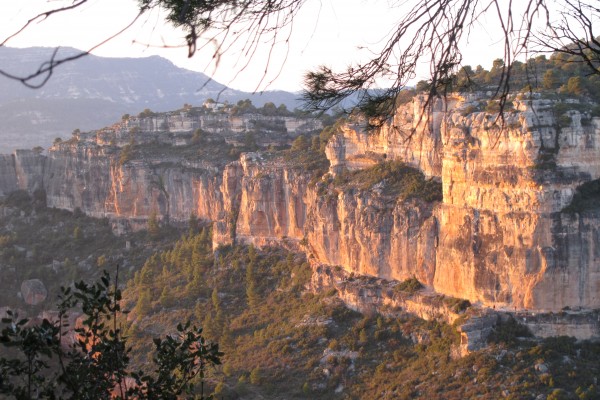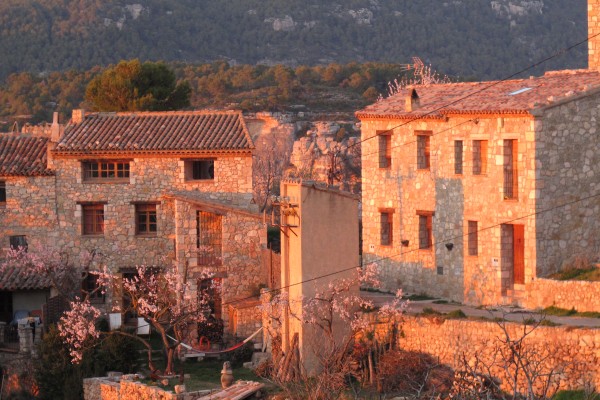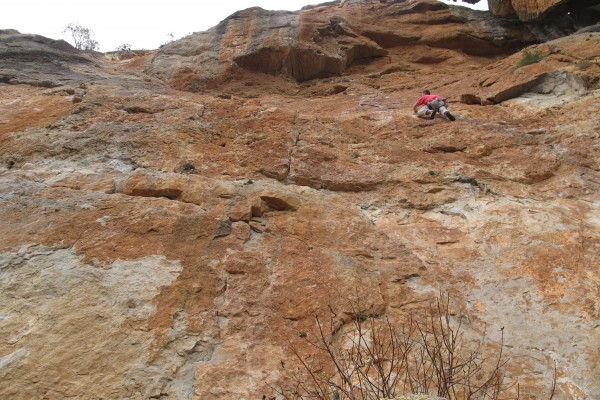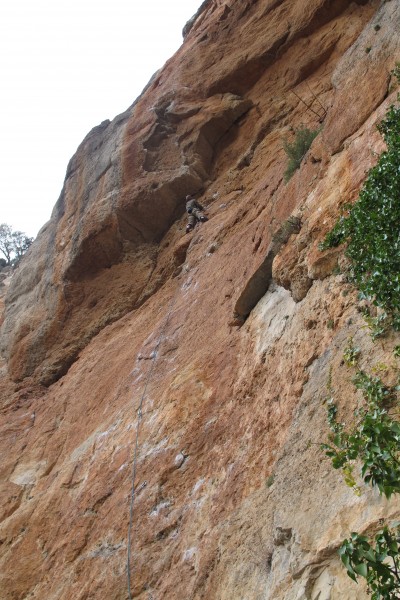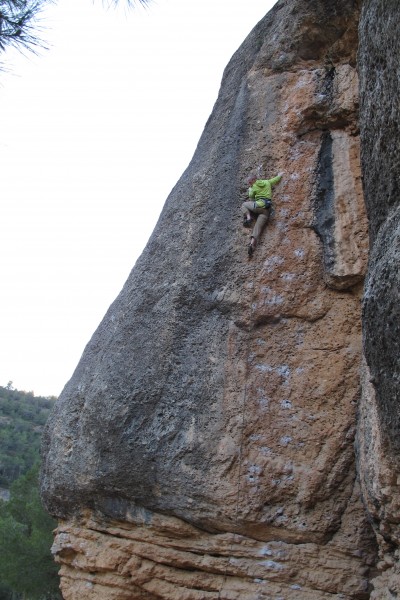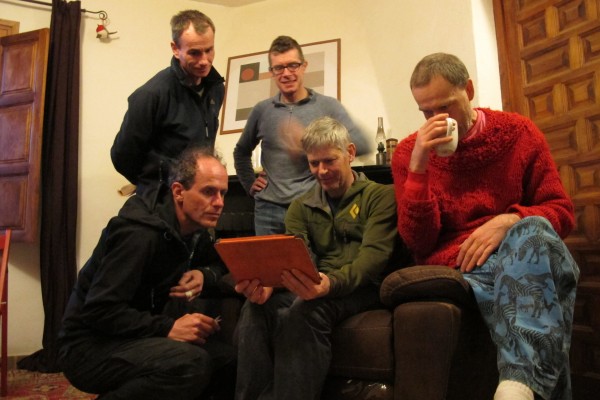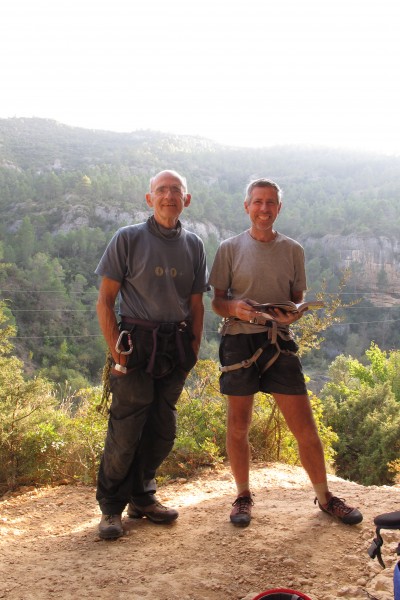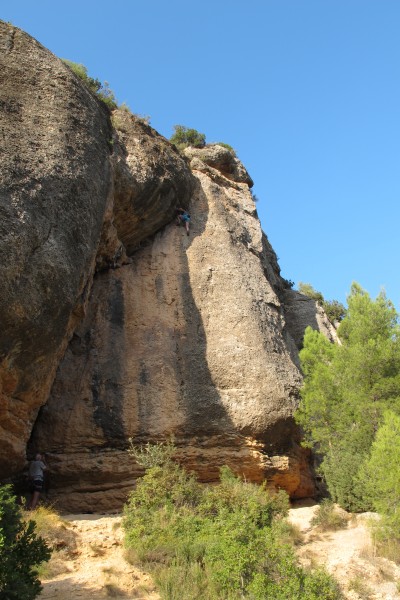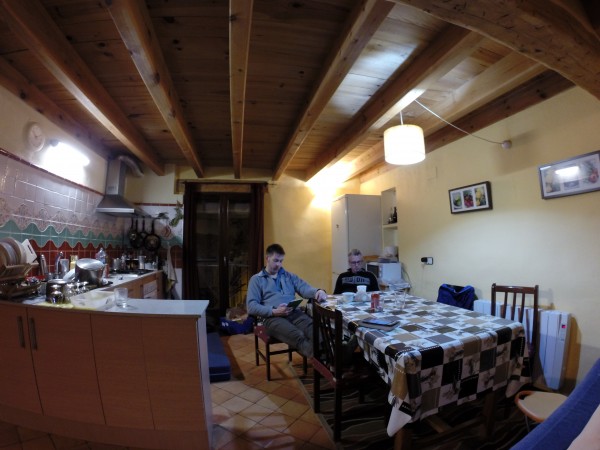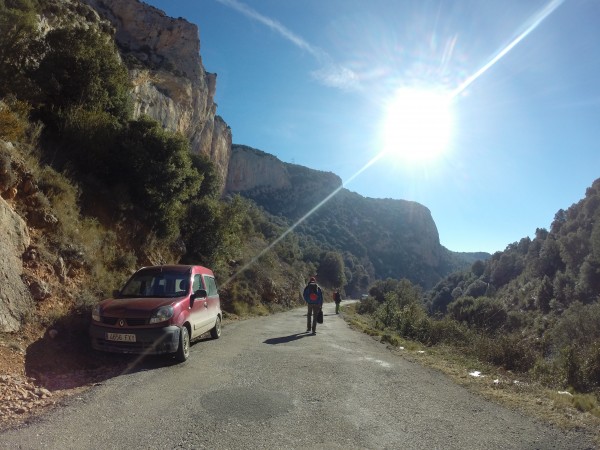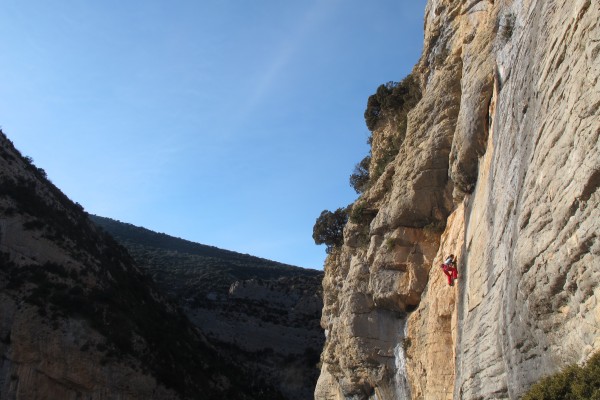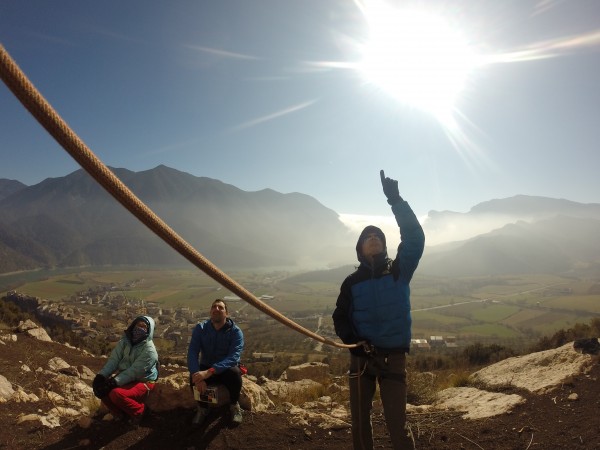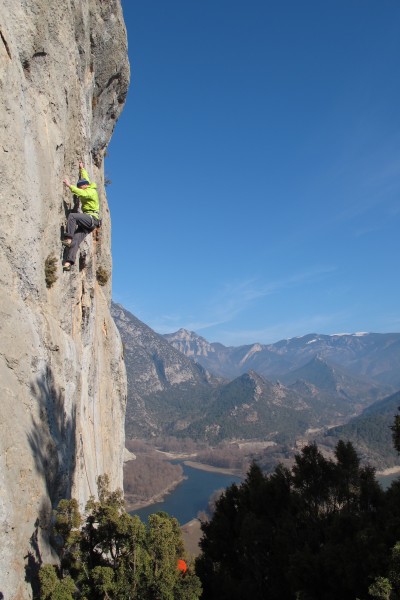Yes, absolutely. Over the last year I’ve made three trips to Catalunya, climbed on some of the best crags I’ve ever visited, and barely scratched the surface. My partners and I have been climbing in the extremely average V to 7a region (5.8 to 5.11d) and never run out of routes. Great rock, stunning views and a welcoming pan-European scene make Catalunya a joy to climb in.
Preparations for the first visit of 2013 were less than ideal. I’d been training well in December and January but February was taken up with urgent house moving, culminating in a hectic week: Wednesday, get the keys to the new flat; Thursday, install carpets and pack; Friday, move all our stuff; Saturday, clean up the old place; Sunday, up at 4am to catch an early morning flight from London to Spain, leaving behind a flat with cardboard boxes stacked to the ceiling and a rather grumpy better half. I was knackered, but it was clear that I had to make this trip count as I wouldn’t be doing much climbing on my return.
We flew to Reus, just south of Barcelona and less than an hour’s drive from Siurana, and were climbing by lunchtime. Siurana consists of two broad areas. The Valley Crags are all easily seen from the road driving up, a set of cliffs facing all directions, including the magnificent El Pati, home to Las Ramblas and other showpieces of high-end sports climbing. Keep on driving up and around the hairpins, and the road takes you to Siurana village, whose houses have huddled on this rocky escarpment for a millennia. The Village Crags sit on the south side of the spur, overlooking a deep wooded gorge.
We spent the next few days exploring both Valley and Village cliffs. Whilst Siurana definitely has most to offer at 6c and above, there are more than enough easier routes to keep you going for days. It’s just a case of picking out the slabbier areas in-between the really steep bits. The rock is a joy to climb on, solid and well-featured limestone, with friendly and sensible bolting.
Although most people stay in Cornudella or other nearby towns, our accommodation on this trip was about an hour’s drive away, along a ridge strung with wind turbines and overlooking the plains of Lleida to the north. Driving at dusk, tired from the day’s climbing, with the car stereo blasting out – of course it would have been easier and more sensible to stay closer, but those drives gave us a sense of the scale of this magical corner of Europe.
After a rest day we upped the ante a little. After some warm-ups, Duncan and I were looking at the sweeping walls of El Pati. Whilst the left-hand side of the crag barrels out and up, the right hand is more amenable and has some fantastic long routes in the lower 7s.
“We’ll do that one,” Duncan said, pointing at a route called Crosta Panic, at 7a+ a bit of a step up for both of us. Half-an-hour later Duncan had dispatched the route, and then I did the same. My hardest ever flash (although it’s really 7a), this was a route of two halves: a thin, technical wall, followed by a roof and short but steep section of jug-pulling to the chains. It’s one thing to push oneself, another to do it on such a fine cliff.
Still, after several days in Siurana we fancied a change, and headed to the rather fashionable Margalef, a small valley lined with conglomerate cliffs. At first sight, it’s not that impressive, a lot of scruffy little crags right by the roadside. I fell off the undercut start to the warm-up route – the rock has a tough quality about it that makes climbing here feel a bit like being punched in the face. Since the easy routes were hard we decided to climb some harder things, which turned out to be excellent. The Margalef of the magazines features an overhanging line of one and two finger pockets, but we climbed some good slabby and merely vertical routes festooned with pockets of all sizes.
Before the drive home we went to take a look at “El Laboratori”. This is really something else, a whorl of grey and black rock smattered with tiny chalked pockets, home to a brace of testpieces including the Sharma super-route “First Round, First Minute”. Just looking at them is enough to set off tendon niggles in your fingers. First Round, First Minute has two holds I’d recognise as such in 40 feet.
I was back in Catalunya in late October, this time not with my regular London climbing partners but two old friends from my hometown in northern England. Preparations for this visit too, were less than ideal. I’d spent September working in South Sudan, and although I did a surprising amount of climbing near the capital Juba, as well as some training in the gym, I wasn’t feeling on top form. Three days before the trip I was bouldering at my local climbing wall. I dropped off the last boulder problem of the night and the instant I landed felt my lower back crumple. By the time I got home I could barely reach down to remove my socks.
“Your back will get better soon – but no climbing for a few weeks!” my doctor said. I took the pills he offered but not the advice. I nearly didn’t go - I was worried I wouldn’t be able actually carry my bag to the car - but decided to try some toproping and threw in an extra novel in case it didn’t work out.
I met Chris and Dave at Barcelona airport and we headed up to our rented apartment in Ulldemolins, a village about 15 minute’s drive from Siurana, surrounded by fields and dramatic hills. I was only planning on top-roping at first, along with Chris who at 69 feels his leading days are over. It went okay, I got up a few easy routes but something was lacking. My body felt a lack of resolve, a sort of feebleness. Of course it did – alongside the anti-inflamatories I was taking strong muscle relaxants to prevent any back spasms. No wonder I was feeling particularly weak!
I decided to restrict the pills to the evenings only, which meant that waking up was like being carried into consciousness on a soft fluffy cloud, but by lunchtime I was okay to put some effort in. Top-roping soon got stale and by the Thursday I’d even taken some leader falls.
Alongside many of the same sectors of Siurana, we went to Arboli, which had some good lines, and Chris and Dave visited the short but sweet hilltop crags at Vilanova de Prades. By the end of the week we’d paid another visit to Margalef. It was the November 1st, we were climbing in shorts in the shade, and up the valley we could see other teams working on fierce-looking projects – it was clear to me on this trip that there’s a huge amount of climbing at Margalef, and would be worth a trip in its own right.
It would have been sensible to go there for the latest visit, a four day weekend in February 2015. But instead we went to the climbing areas around the city of Lleida, to the north of the Siurana region. The crags are superb but everything is a bit more spread out, making for a fair bit of driving in a short trip. But I wanted to visit some new areas so Lleida it was.
Rather than take one of the bargain airways which fly from London’s peripheral airports, we went with British Airways from Heathrow – this would be ideal for the travelling climber going to Spain via the UK. It’s a bit more of a civilised experience, too. The hire car company was quick and efficient (don’t go for Goldcar in Barcelona, as their offices and parking are a bus ride away – extra faff in a short trip), and we were soon heading up to the hills. But it was cold. Really cold. Snow covered the ground and we had visions of dripping crags and baltic conditions.
We were basing ourselves in the village of Vilanova de Maia, in a little refugio in the centre of the old village, up narrow streets too small for a car. In the morning we saw what a stunning situation this village is in, surrounded by mountains and cliffs, bathed in light from the bluest, clearest skies. Sutri, the refugio’s owner and a climber himself, took some of the team off to the tiny shop and showed them the best olive oil and manchego cheese.
For our short first day we climbed at some cliffs near the village. There are some reasonably graded five and six pitch climbs on one side of the gorge, but we were here for single pitch sports routes. Despite crunching up snow on the approach, conditions at the crag were excellent, down to t-shirt or a light jumper. After some warm-ups we got on an excellent 6c called Hobbit. I was climbing with Mark, an old university friend who regaled me with tales of doing an ironman in the summer. This was his first climbing trip in a long time and he was psyched… but then disaster struck. Climbing up a delicate groove on Hobbit he did something to his shoulder on a long press move, and was soon in a lot of pain.
The next morning he went running whilst the other five of us visited La Pauta, a stunning cliff virtually unknown outside of Catalunya. It’s a vertical cliff, around 30m high, whose limestone reminded me of climbing in Provence or even the Verdon. I was half-way up my route when I started hearing my mate Mat make a lot of noise on the neighbouring route, El Secreto está en Aneto, 7a. It was one of the most impressive leads I’ve seen in a while – he was throwing everything at this pitch, really giving it his all. I hung off a big jug, watching him working away at the meat of the climb, a 15m section of slightly overhanging, sustained wall climbing, until the pump beat him and he took a rest.
Despite seeing Mat do some of the route, when I started out on the difficult section of El Secreto it felt fairly onsight, working my way up an indistinct line of holds, awkward and technical. By the top I was getting pumped and starting to really fight to stay on, all thoughts of a fall were pushed out of my mind and the moves kept on flowing. It just felt so good. This is why we go sports climbing!
On our third day the valleys were drenched in a frigid fog, the fields hard and the bare trees covered with frost. We drove up and up, towards the Pyrenees, suddenly bursting out into bright sunshine near Col de Nargo, our destination for the day. Although the crag faces south and was getting all the sun going, the wind had swung around to the west and whipped along the crag, making it hard to stay warm. Still, it was more superb and fingery climbing.
We were all feeling beat up on Monday. Daniel had bashed up his knee pretty badly trying a hard route at Col de Nargo and Tania had struggled with the cold. Along with Mark, they headed to Barcelona for lunch at a beachfront restaurant, whilst Mat, Ian and I went to Cubells for a last few hours cragging. High above a slightly Tolkienesque landscape of villages and castles, Cubells had some sharp rock and tough routes. We got in the car at 1.30pm and by 8.30pm I was home in London.
Two-and-a-half weeks is barely enough time to get started in Catalunya. Aside from Oliana and Santa Linya and all the other places you see in the magazines, there are so many other crags here “on the list”: the soaring conglomerate walls of Montsant, the shady summer-time cliffs at Camrassa, the gorge of Tres Ponts, the multi-pitch routes at Vilanova de Meia. Get to it!
